Best VRChat Microphones: Top Picks and Buying Guide by Budget

Index
- Is a Microphone Necessary for VRChat Streaming?
- Why Are Microphones Important? The Value of “Voice” in VRChat Streaming
- Know the Types! Microphones and Their Characteristics
- Microphone Selection Points Depending on Usage Environment
- Microphone Selection Checkpoints
- Recommended Microphones for VRChat Streaming by Price Range
- Useful Equipment and Accessories Besides Microphones
- In Conclusion
“I want to stream on VRChat, but do I really need to buy a microphone?” Many people might be pondering this question.
VRChat primarily uses voice chat as a means of communication. To deliver “your voice” to your audience, the quality of your microphone is very important.
In this article,
- Is a microphone really necessary for streaming on VRChat?
- What types are available?
- What are some recommended microphones for beginners and intermediates?
We will concisely summarize and introduce the information that VTubers or streamers with avatars should know first.
Is a Microphone Necessary for VRChat Streaming?
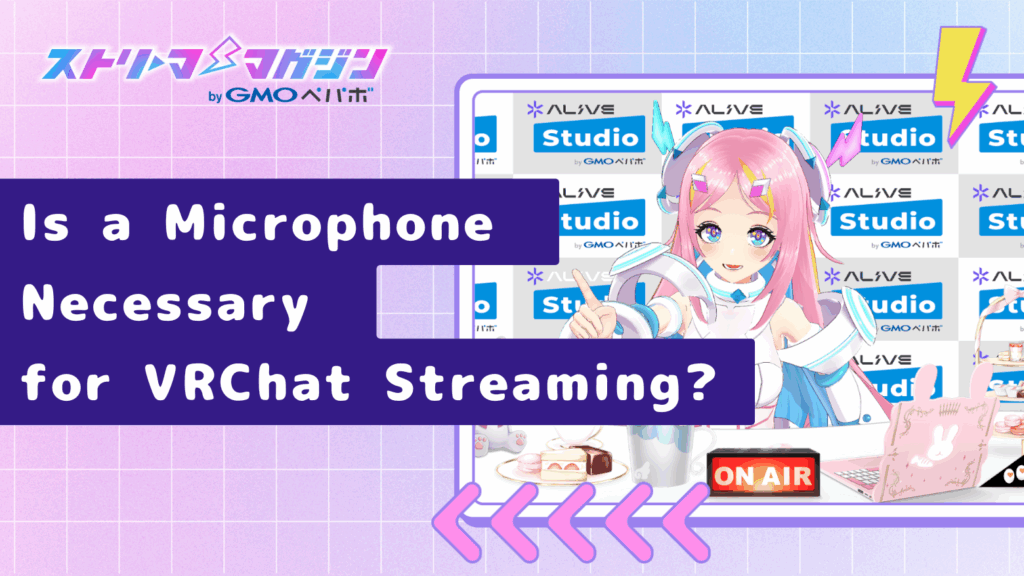
When starting to stream on VRChat, it’s not uncommon to wonder, “Do I need to get a separate microphone?” In conclusion, you can stream solely using the microphone built into your VR headset, but if you aim for comfortable and high-quality streaming, it’s recommended to use an external microphone.
Audio is the core of the information received by viewers. Even if the video is somewhat rough, a clear audio still qualifies as a good stream. Conversely, muffled or noisy audio can be a reason for viewers to leave.
Streaming is Possible with Built-in Headset Microphones
VR headsets like the Meta Quest 2 or 3 come with built-in microphones, enabling voice chat and streaming without additional equipment. In fact, speaking on VRChat, recording, and streaming directly to YouTube with Quest alone is possible.
For beginners who are more focused on experimenting or minimizing costs, built-in microphones can fully set the starting point.
However, External Microphones Are Advantageous in Terms of Sound Quality and Stability
Built-in microphones are convenient, but they have several shortcomings.
One issue is that their sound can be muffled and lacks clarity. The reason is that the microphone is often located away from the mouth and is more prone to picking up surrounding noises.
Moreover, as your head orientation changes frequently during VR sessions, maintaining a consistent distance and angle to the microphone is challenging, leading to inconsistent voice volume.
Particularly with the Meta Quest series microphones, users have often reviewed them as having “noticeable noise” and sounding “distant”.
For these reasons, if you want to deliver easily understandable audio to listeners, introducing an external microphone is effective.
The next section delves deeper into why “microphone sound quality” is so crucial in VRChat streaming.
Why Are Microphones Important? The Value of “Voice” in VRChat Streaming
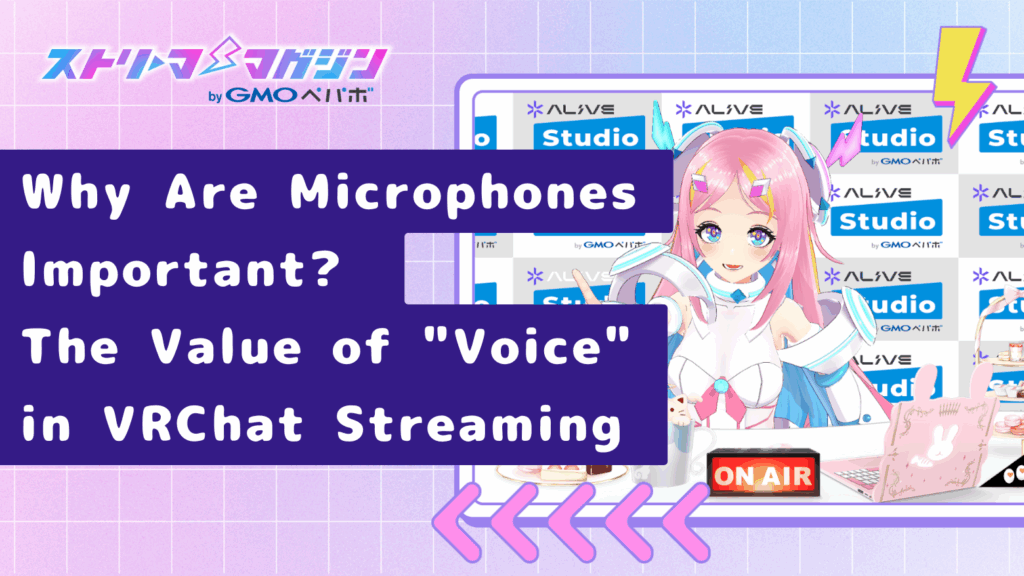
In VRChat streaming, the quality of the microphone transcends mere equipment concerns.
“Voice” is another expression of “yourself” alongside your avatar. Let’s explore why microphones significantly influence the streaming impression.
The Impression of Your Voice Sets the First Impression for Listeners
In avatar-based streaming like VRChat, visual expression is vital, but the most direct element to reach listeners is the “voice”. Especially in content focusing on chatting, collaboration, or song streaming, the impression of the voice significantly impacts the streaming quality.
Clear audio ensures content is communicated smoothly and gives assurance and comfort to the stream itself. Conversely, excessive noise or inaudible voices cast a negative impression on the stream, leading viewers to drop out.
In VRChat, as you converse or express yourself through your avatar, the voice is directly linked to “your character”. If the audio is muffled or cuts off, it doesn’t convey the full appeal of the avatar you’ve meticulously crafted.
Impact on Engagement and Realism in Streaming
Furthermore, in styles focused on collaborations between streamers or conversations with viewers, clarity and stability of the voice influence the interaction tempo and trust.
If the audio quality is up to standard, it increases the likelihood of viewers thinking, “This stream is easy to listen to,” and “I want to watch again.”
As you can tell, the “microphone quality” significantly affects the initial impression of the stream.
Up next, we’ll discuss the different types of microphones used in VRChat streaming and their characteristics.
Know the Types! Microphones and Their Characteristics
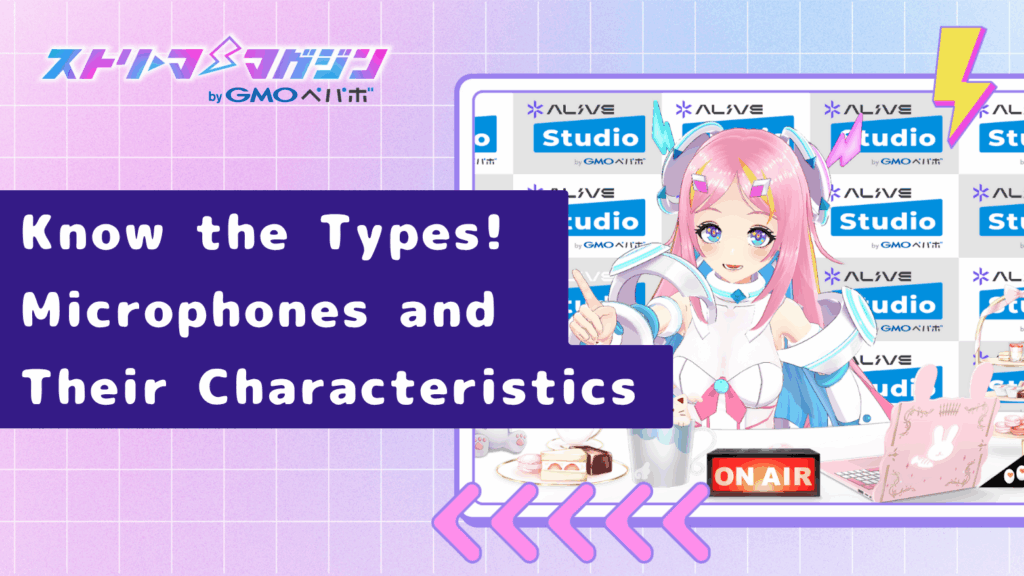
When it comes to VRChat streaming, you might wonder, “I understand microphones are important, but what specific types are there?”
Microphones come in several types, and their compatibility varies based on connection method and form. Here we introduce typical types of microphones commonly used for streaming.
Choosing by Connection Type: USB Microphones and XLR Microphones
The first thing to pay attention to is how the microphone connects to the PC. They generally fall into “USB Microphones” and “XLR Microphones”.
USB Microphones
- Microphones that can be connected directly to a computer via USB cable
- No need for additional equipment like an audio interface
- Easy to handle, making them popular among streaming beginners
- Recently, more models offer high-quality sound with good price-performance balance
If you’re introducing a microphone for streaming for the first time, starting with a USB microphone is practical.
XLR Microphones
- A professional standard microphone that connects via a 3-pin port
- Cannot be connected directly to a PC, requires an audio interface
- Known for excellent sound quality, noise resistance, and expandability. Best for experienced users familiar with streaming
If you want to pursue sound quality and are considering vocal recording or collaborative streaming in the future, XLR microphones become a potential choice.
Choosing by Form: Select Type According to Usage
Microphones are not only categorized by connection type, but also by installation method and usage location. In VRChat streaming, choosing a microphone shape suited to your usage style is also essential.
Desktop Microphones (Stand Type)
- The most common type designed for use placed on a desk
- Often condenser mics, superior in sound quality
- Position adjustments are possible when used with an arm stand
This type is recommended for styles where you sit at your PC while streaming, as it is user-friendly and offers high sound quality.
Headset Microphones
- Type with the microphone integrated into the headphones
- Maintains an acoustic amplitude while being fixed at mouth position, providing stable sound even when moving
- Compatible for use alongside VR headsets
Ideal for those who want to stream while moving or seek a configuration that doesn’t interfere with VR goggles.
Lavalier Microphones
- Small microphone attached to clothing
- Less conspicuous, enabling natural-looking streaming
- Useful for those who want to move while using
However, some models easily pick up surrounding noise, requiring consideration of the usage environment.
Wireless Microphones
- Use without cables, allowing for free movement
- Sends audio to the PC using a transmitter and receiver
- Can be adapted for dance streaming or streaming using full-body tracking
Although slightly high in price, they offer a comfortable streaming environment without the hassle of cables.
Understanding microphone types enables you to choose one suited to your streaming style. Next, we’ll discuss which microphones are suitable for different usage environments.
Microphone Selection Points Depending on Usage Environment

In VRChat streaming, the required performance and ease of use of a microphone vary significantly based on your play style and equipment setup.
Here, we introduce which microphones are suitable for common streaming environments.
When Streaming from a PC Desktop
In case of “desktop streaming” while playing VRChat on a PC, you have relatively more freedom to choose a microphone.
Especially, USB desktop microphones, or condenser mics used with mic arms, are convenient to use, providing an environment to achieve high sound quality.
Choosing a “unidirectional (cardioid)” microphone to avoid picking up PC fan or keyboard noise contributes to noise control.
If you stream in a stable seated position, you can maintain good sound quality since the mic’s position is fixed.
When Streaming with Standalone VR (Quest Only)
When using Meta Quest 2 or 3 standalone, without connecting to a PC, use of external microphones is restricted.
Currently, it’s generally only possible to use the built-in microphone, and the direct connection of USB microphones often isn’t recognized.
Thus, in standalone streaming, while assuming the built-in microphone, prioritize using it in a quiet room and focus on checking sound before recording and streaming.
Moreover, combining external mic audio via a smartphone or PC is an option, but the setting difficulty suits intermediate users or above.
When Streaming in a PCVR Environment (Quest+PC Link or PC VR Device)
If you connect Quest to a PC using SteamVR or play with a PC VR headset, you can use external microphones the same way as in “PC desktop streaming”.
In such cases, if large body movements are involved, microphones like headsets or lavaliers that can be worn are preferable over desktop microphones.
Notably, during streaming styles incorporating full-tracking movements or dancing, a wearable mic that maintains a stable distance from the mouth is advantageous.
This way, choosing a microphone that fits your streaming environment ensures a comfortable and stable streaming experience.
The next chapter provides more insight into the points to check upon choosing a microphone.
Microphone Selection Checkpoints
When selecting a microphone for VRChat streaming, don’t decide based solely on price or appearance. Instead, thoroughly verify that the microphone aligns with your streaming style and environment.
Here, we introduce six checkpoints to focus on before purchasing.
1. Is It Suitable for Your Application?
First, clarify what kind of content you aim to stream.
- If chatting is the main focus, a mic that delivers a natural voice unaltered
- For music or ASMR that requires sound quality, a high-performance mic that captures delicate sounds
- If you plan lots of movement during streams, wearable or wireless types are convenient
Choosing a mic suited to your applications ensures understandable, attractive streams for viewers.
2. Sound Quality and Directionality
Microphones differ in their sound pick-up performance (sound quality) and the directionality of sound capture.
- Condenser mics: Capture delicate sounds but are sensitive to ambient noise
- Dynamic mics: Resistant to surrounding noise, adds depth to the voice
Additionally, choose directionality as follows:
- Unidirectional (Cardioid): Ideal when focusing on capturing only your voice
- Omnidirectional: Convenient for group conversations or when expecting lots of movement
Think about how you want to capture sound according to your streaming environment and style.
3. Noise Resistance
Streaming can involve various environmental noises such as air-conditioning sounds, PC fans, and outdoor noise.
A noise-resistant microphone, or one with a noise-avoiding directionality, makes audio more understandable to viewers.
Although streaming software can apply noise filters, the higher the microphone’s performance, the more natural the processing.
4. Ease of Setup and Handling
Review how the microphone will be set up based on your available streaming space and movements.
- Small stands for desktop use
- Mic arms to utilize desk space effectively when the desktop area is limited
- Headset type or lapel mics for talking while moving
Make sure the microphone does not distract by appearing prominently in the streaming frame.
5. Budget Compatibility
Microphones vary widely in price, from thousands to tens of thousands of yen.
- Beginners can achieve adequate performance with USB microphones priced below 10,000 yen
- For more serious streaming, consider 20,000-30,000 yen range microphones or XLR setups
It’s recommended to include a budget for pop guards, arms, and other peripherals as needed.
6. Connectivity and Compatibility with PC
Check if the microphone is USB or XLR connected, and ensure compatibility with your PC or VR equipment.
- USB Microphones: Directly connectable to a PC
- XLR Microphones: Requires an audio interface (e.g., AG03)
Consider introducing an XLR microphone if you plan on using multiple microphones or if you want to delve further into sound quality improvements.
In the next chapter, leveraging these points, we introduce recommended microphones for “cost-effective” and “quality-oriented” price ranges.
Recommended Microphones for VRChat Streaming by Price Range
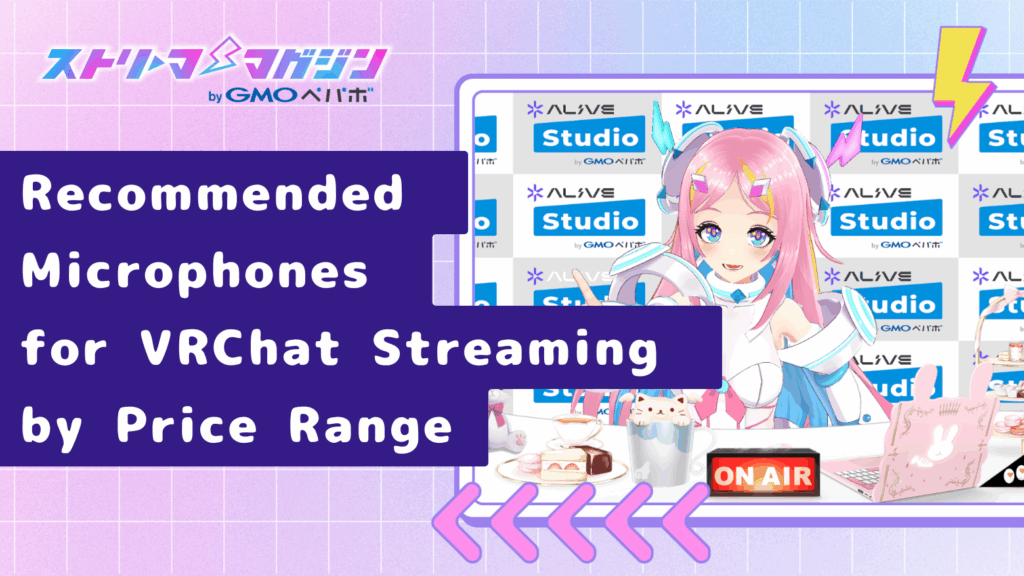
From here, based on the selection points discussed, we introduce recommended microphones for VRChat streaming, split into “beginner” and “intermediate & advanced” price categories.
Find the perfect microphone for yourself by considering your streaming style and budget.
For Beginners: Cost-effective Models Under 10,000 Yen
This price range is for those who are introducing a microphone for the first time or wish to “improve sound quality first”.
Models that are easy to use with USB connections and have enough performance to support streaming are introduced.
Blue Snowball iCE (Logitech)
- A standard USB-connected model. Features a ball design
- Uni-directional, making it easy to capture only your voice
- Achieves high sound quality effortlessly, recommended as a first microphone
Possesses a good balance of sound quality, design, and price, and is highly rated by streaming beginners.
Razer Seiren Mini
- A compact USB microphone, easy to set up due to its size
- Cardioid directionality makes it easy to mute surrounding noise
- Stylish look with abundant color variations
Simple and easy to use, suitable for game and chat streaming.
HyperX SoloCast
- A small USB microphone with unidirectional characteristic
- High functionality with tap-to-mute feature
- Popular among game streamers and proven in the field
A microphone offering adequate performance for its price for streaming.
SONY ECM-PCV80U
- Includes an analog mic with a USB conversion cable
- Comes with a complete set, ready to use immediately
- Natural sound quality, compatible with video conferencing or streaming purposes
Suitable for those who want to introduce a microphone with minimal components.
For Intermediate to Advanced Users: Quality-focused Models (10,000-30,000 Yen Range)
This price range is for those familiar with streaming or those who want to focus on sound quality seriously.
Beyond high-performance USB models, an XLR mic plus audio interface setup also becomes an option.
Shure MV7
- A hybrid model supporting both USB and XLR
- A dynamic microphone optimized for streamers
- Touch controls for volume adjustment and muting
Continuing the lineage of the professional SM7B mic, this offers the perfect fit for streaming in terms of sound quality and functionality.
Blue Yeti X
- USB connection with switchable 4-direction patterns (unidirectional, omnidirectional, etc.)
- Supports high-resolution audio recording (24bit/48kHz)
- Includes a meter for adjusting volume and gain on the device
Versatile for various styles such as chatting, singing, or multi-person streaming.
RODE Wireless GO II
- A wireless microphone system
- Selectable use of lapel mic or built-in mic
- Ideal for those who want to stream while moving freely
Being cable-free makes it perfect for VR streaming or dance streaming that uses full tracking.
When choosing a microphone for streaming, it’s crucial to select one that fits your style and environment rather than merely focusing on price or brand.
Useful Equipment and Accessories Besides Microphones
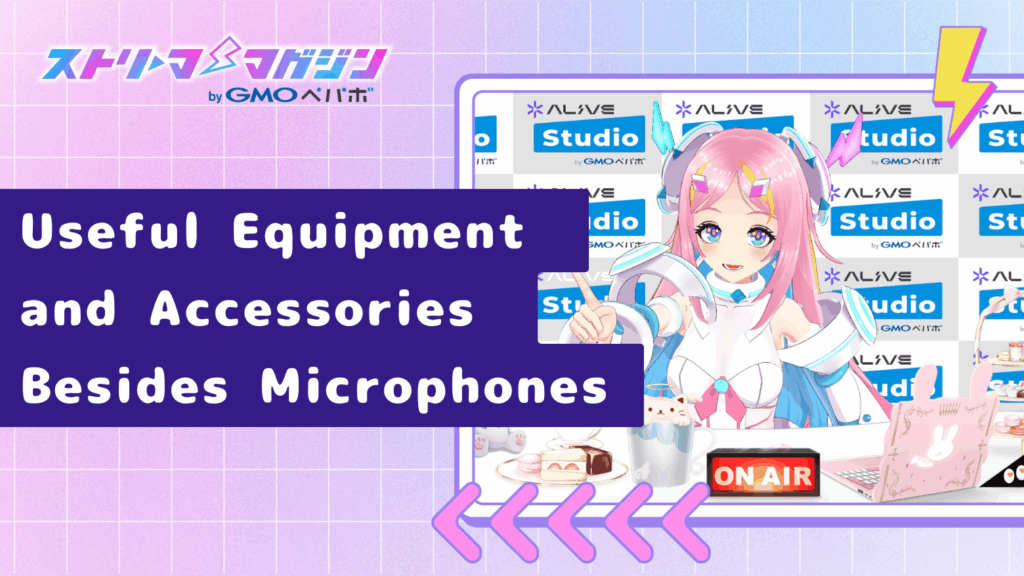
While introducing the microphone itself greatly improves sound quality, equipping several surrounding equipment ensures an even more comfortable and stable streaming environment.
Here, we introduce accessories and equipment that are beneficial for VRChat streaming.
Pop Filters and Windscreens
Pop filters are accessories installed in front of microphones to suppress popping sounds (P and B sounds) and breath noise.
In streams where talking at close proximity is frequent, it protects against noise issues due to direct breathing on the microphone.
Furthermore, foam windscreens attached to the microphone head also work as simple noise countermeasures.
Microphone Stands and Arms
Stands or arms are recommended for stabilizing the microphone position.
- Desktop stands: Compact and easy to install
- Microphone arms: Allow for flexible positioning, utilizing desk space efficiently
It becomes easier to bring the microphone closer to the mouth, maintaining stable sound quality, while also reducing the impact of keyboard noise and desk vibrations.
Shock Mounts
Shock mounts are mountings designed to absorb vibrations and impacts transmitted to the microphone. They reduce unintended noise from desk shakes or keyboard strokes.
Especially when using highly sensitive microphones like condenser mics, introducing shock mounts allows for clearer audio recording.
Audio Interfaces (For XLR Microphones)
To use XLR microphones, an audio interface is necessary to connect to the PC.
Popular models include Yamaha AG03 and Focusrite Scarlett series, widely used among streamers.
Using an audio interface allows for mic volume control, BGM balance adjustments, and echo effect additions.
Headphones and Earphones
Using speakers during streaming can lead the microphone to pick up audio, causing feedback and duplicate sound issues.
Hence, always use headphones or earphones when using a microphone.
- Closed headphones: Less likely to leak sound and pick up external sounds
- Lightweight earphones: Suitable for long use, easy to pair with microphones
With interfaces or microphones that have a “monitoring function” to check your voice in real-time, more precise streaming becomes possible.
These accessories are not mandatory, but they improve sound quality and operation, enabling more stable streaming.
For those curious about starting VRChat streaming with OBS and recommended settings, please refer to the following article.
How to Start Streaming VRChat with OBS: A Beginner’s Guide and Recommended Settings
In Conclusion
In VRChat streaming, choosing the right microphone is an essential factor directly affecting the viewing experience.
While streaming can begin with a built-in microphone, it’s effective to introduce an external microphone if you value sound quality and stability.
This article has focused on the following points:
- In VRChat streaming, “voice” is as important as the avatar for expression
- Concepts for selecting microphones according to streaming environment (PC, standalone, etc.)
- Recommended microphones for beginners through to advanced users
- Peripheral equipment and accessories to use alongside microphones
There is no definitive answer to microphone selection, but finding the optimal unit according to your streaming style and quality goals is essential.
Start with easy-to-handle USB microphones, and once you are accustomed to streaming, consider upgrading to models with superior sound quality and functionality.
To make the first step in streaming more comfortable and attractive, use this article as a reference for selecting a microphone.
This time, we have explained the need for microphones in VRChat streaming, various types, selection methods, recommended models, and peripheral equipment. Implementing an external microphone is vital for aiming at more comfortable and higher-quality streaming on VRChat. Deliver your voice clearly and enrich communication with listeners. After purchasing a microphone, why not try streaming on OBS as well?








